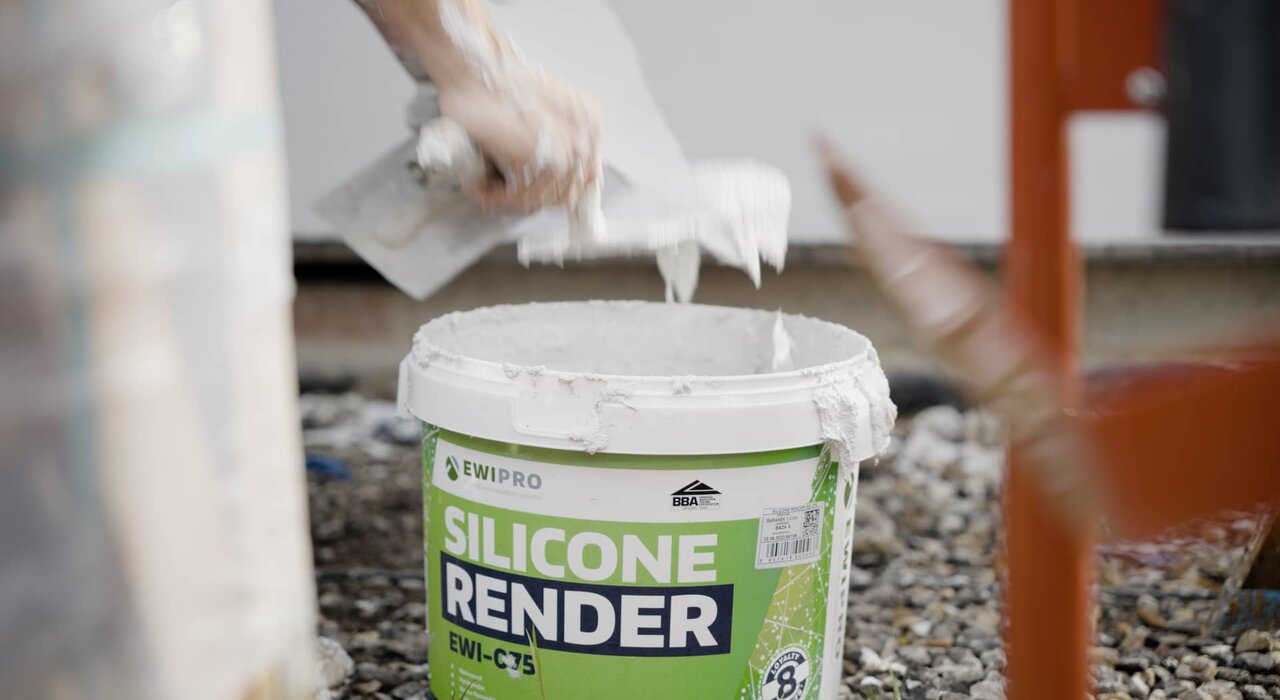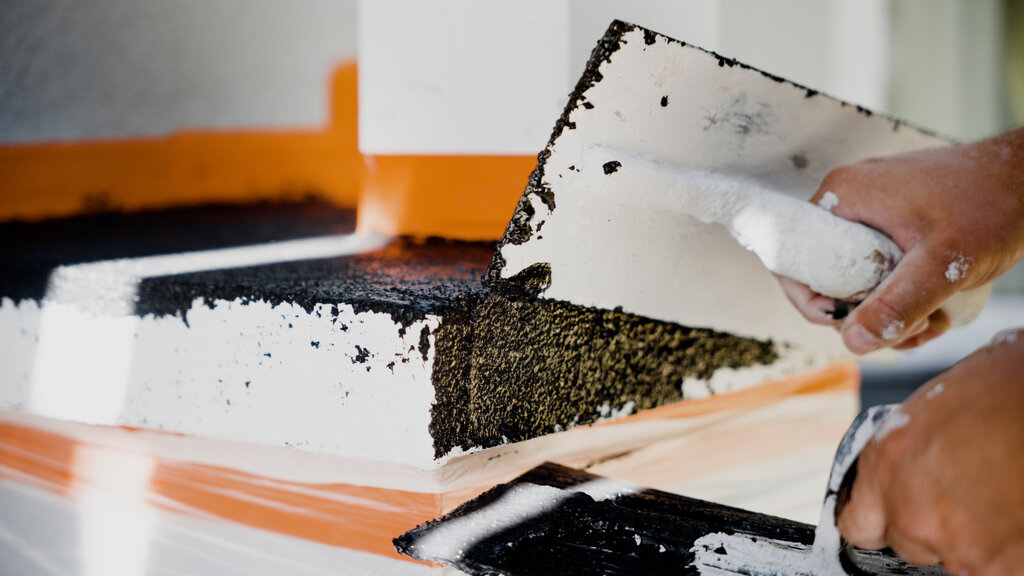
In the realm of construction and exterior building aesthetics, thin coat render emerges as a highly sought-after option. But what exactly is a thin coat render system, and why has it become so prevalent in modern building projects? This blog aims to unravel the essence of thin coat render, its benefits, and its applications.
What is a thin coat render?
Thin coat render is a type of external wall finish applied to buildings. It is typically used as the final coat in a multi-layer rendering system and is known for its smooth and often textured finish. Unlike traditional sand and cement render, thin coat render is often premixed and comes in a variety of finishes, textures, and colours. It is generally made from a mix of silicone or acrylic resins, along with various fillers. It is applied in a much thinner layer than traditional renders, usually ranging from 1 to 3 mm in thickness. When it comes to EWI Store Silicone Render, the thickness of the application will match the chosen grain size. Applying a thin coat render system often involves first applying a basecoat or a primer to the wall, followed by a mesh layer for additional strength. Finally, the thin coat render itself. The render is usually trowel-applied and can be textured or smoothed to achieve the desired finish. It is known for its flexibility, which makes it less likely to crack over time compared to traditional rendering methods.
The benefits
Durability
Thin coat render often incorporates advanced synthetic materials such as silicone or acrylic resins. These materials are formulated to be highly resistant to wear and tear, as opposed to traditional render, which is generally a mix of sand, cement, and lime. This compositional difference gives thin-coat renders their superior durability. One of the primary issues with traditional render is its susceptibility to cracking over time, especially in fluctuating weather conditions. The flexible nature of a thin coat render system accommodates minor movements in the building structure, thereby reducing the risk of cracking. High-quality thin coat render often contains UV-resistant additives. This means it is less likely to fade or break down when exposed to direct sunlight over extended periods. Thin coat render offers excellent resistance to various environmental factors, including wind, rain, and salt spray in coastal areas. This long-lasting resistance helps maintain the building's aesthetic and structural integrity. Thanks to these durability factors, thin coat render systems generally have a longer lifespan compared to traditional renders. While conventional cement-based renders may need reapplication or significant repair work within a decade or so, high-quality thin-coat renders can last much longer with minimal maintenance. As a result, they are more cost-effective in the long run. Because you can opt for a pre-coloured thin coat render, the issue of paint peeling or fading is virtually eliminated. The colour is integrated into the material, ensuring long-lasting vibrancy and reducing the need for frequent repainting.
Flexibility
Buildings are not static structures. They are subject to subtle movements due to a variety of factors, like temperature fluctuations, ground settling, or even seismic activity. Traditional render systems can be rigid and may not tolerate these movements well, leading to cracks or other types of failures. The flexibility inherent in thin coat render allows it to accommodate these minor movements, thereby reducing the likelihood of cracking. Temperature changes can cause materials to expand or contract. The flexibility of a thin coat render allows it to better handle this natural thermal expansion and contraction without cracking, compared to a more rigid traditional render. The flexible nature of thin coat render makes it adaptable to a variety of substrates, including but not limited to brick, blockwork, and insulation boards. This makes it a versatile option for different kinds of construction projects. Flexibility also gives a thin coat render system a certain level of resilience against physical impacts. While it won't make the wall bulletproof, the render's ability to 'give' slightly when impacted can prevent or minimise surface damage. Should any damage occur, the flexible nature of the material often makes repairs easier and more seamless. With traditional render, patch repairs can be obvious and sometimes even structurally compromised due to differences in material flexibility. Modern building techniques often employ materials and methods that are themselves somewhat flexible or subject to movement. Thin coat render's flexibility makes it compatible with these modern methods, providing a more integrated and resilient system overall.
Aesthetic versatility
One of the key benefits of thin coat render is the wide variety of textures and finishes it can offer. Whether you're looking for a smooth, sleek surface or a more textured, rustic appearance, there's likely a thin coat render product to match your vision. From scraped and brushed finishes to pebbled and even custom designs, the options are numerous.
Thin coat render can come pre-mixed in a vast array of colours, giving homeowners and designers greater creative freedom. This eliminates the need for external painting and offers a more durable colour that is less likely to fade or peel over time, thanks to the colour being integrated into the material itself.
Unlike traditional render, which might exhibit variations in colour or texture due to inconsistencies in the mix or application, it provides a more uniform finish. This ensures that the building's aesthetic appeal is maintained across different sections of the wall.
Some thin coat render systems allow for incorporating patterns or even logos into the finish, allowing for a high degree of customisation. This can be particularly useful for commercial properties looking to reinforce branding or for homeowners wanting a unique aesthetic feature.
The smooth and even finish achievable with a thin coat render is often associated with a modern, contemporary look. This makes it an attractive option for new builds or refurbishments where a more updated aesthetic is desired.
Because of its versatility, thin coat render can be used strategically to highlight the architectural features of a building. For example, a smooth finish could be used on the main walls, with a contrasting texture or colour on features like columns, window surrounds, or cornices.

Weather resistance
Thin coat render systems often have excellent water-repellent properties. The render acts as a barrier that helps shed water, thus minimising the risk of water penetration and subsequent issues like dampness and mould that can arise from it. This is particularly useful in regions with high levels of rainfall or humidity.
The robust nature of thin coat render means it stands up well to wind exposure. This can be particularly beneficial in coastal or open areas where wind-driven rain or salt spray can be a concern.
High-quality thin coat renders are often formulated with UV-resistant additives. This means that the material and colour are less likely to degrade or fade upon exposure to direct sunlight, ensuring that the building maintains its aesthetic appeal for a longer period.
The flexible properties of the thin coat render also make it resistant to freeze-thaw cycles. This can be particularly damaging to traditional render systems. This means that it's less likely to crack or suffer from surface degradation in climates where temperatures can fluctuate around the freezing point.
 Many premium thin coat renders are designed to resist the growth of algae, moss, and fungi. This is important for maintaining the building's aesthetic quality and contributing to a healthier living environment.
Salt spray can be corrosive to building materials in coastal areas. Thin coat render systems often have better resistance to salt, making them ideal for properties near the sea.
Many premium thin coat renders are designed to resist the growth of algae, moss, and fungi. This is important for maintaining the building's aesthetic quality and contributing to a healthier living environment.
Salt spray can be corrosive to building materials in coastal areas. Thin coat render systems often have better resistance to salt, making them ideal for properties near the sea.
Breathability
One key feature of a breathable thin coat render is its ability to allow water vapour to pass through the material. This allows moisture from within the building to escape, thereby reducing the risk of condensation, dampness, and mould growth.
Breathable render helps maintain a balanced moisture level within the wall structure. Traditional, non-breathable renders can trap moisture, leading to potential structural issues like rotting timber frames or corrosion of metal elements.
By allowing the building to 'breathe', thin coat render contributes to better indoor air quality. A breathable render can help reduce humidity levels inside the property, thereby mitigating the conditions that lead to mould and mildew. This is particularly beneficial for people with allergies or respiratory issues.
Its breathable nature makes it adaptable to a wide range of climates. In humid or rainy conditions, it allows excess moisture to escape. Alternatively, in drier climates, it can help regulate humidity within the building, contributing to a more comfortable living environment.
When used in conjunction with breathable insulation materials, thin coat render can contribute to an overall wall system that effectively manages moisture. Therefore, it enhances thermal efficiency and the long-term durability of the structure.
The ability of thin coat render to allow moisture to escape helps preserve the building's structural integrity. Excess moisture can weaken traditional building materials over time, so breathable render can contribute to the building's longevity.

Other benefits
As it comes premixed, thin coat render is quicker to apply than traditional methods. Because it is applied in a thin layer, it also adds less weight to the building's structure. Due to its durability, weather resistance, and colour stability, thin coat render typically requires less maintenance over the years.
